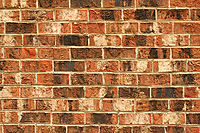Key:bond
| Description |
|---|
| Used to describe the bond type used on a brick building or wall. |
| Group: buildings |
| Used on these elements |
| Requires |
|
building:material=brick, building:facade:material=* or material=brick |
| Useful combination |
| Status: in use |
| Tools for this tag |
|
The key bond=* can be used to nano map the bond of a brick wall. This can be interesting for historical research or 3D rendering of the building/ wall.
How to map
Important note: Do not analyse the bricks between windows, as the brick layer mostly tried to fill the space as best they could; focus on the areas above and below windows or gable ends instead.
Add building:material=brick or building:facade:material=* to a building or wall=brick to a free standing wall.
Add the key bond=* and one of the following values (list might not be complete, because these depend on the regional tradition of brick layers). It is possible to add several bonds to a building, separated by semicolon.
| value | image | definition | in other languages[1] |
|---|---|---|---|
stretcher_bond |
Overlapping courses of stretchers, i.e. the long face of the brick. | Dutch: Halfsteensverband
French: Appareil courant ou en panneresse Spanish: Aparejo a sogas Portugese: Aparelho à meia vez "esquerda-direita" | |
raking_stretcher_bond |
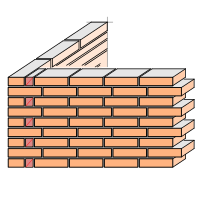 |
Courses of stretchers with every second course set off by a quarter stretcher. | Danish: Løberforbandt
Dutch: Klezoorverband |
header_bond |
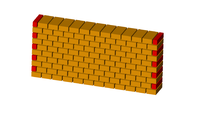 |
Overlapping courses of headers, i.e. the short face of the brick.
Common in the South of England. |
French: Appareil courant ou en boutisse/ appareil debout
Spanish: Aparejo a tizones |
flemish_bond |
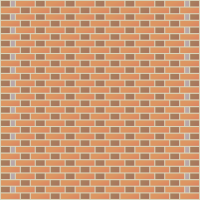 |
Alternating stretchers and headers.
The earliest example in England is Kew Palace (1630s). |
Dutch: Vlaams verband
French: appareil flamand |
english_garden_wall_bond |
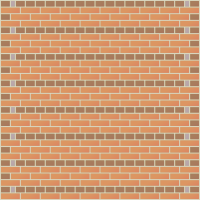 |
A course of headers followed by three courses of stretchers.
Also called American bond, garden wall bond or Liverpool bond. |
|
monk_bond |
 |
Two stretchers, followed by one header. Stretchers overlap by a quarter brick; headers align by every second course. | Dutch: Kettingverband/ Noors of Noords verband |
english_bond |
 |
Also known as Common bond in the UK, dating as far back as Tudor times. Strongest bond, and therefore often used for foundations. [2] Alternating courses of stretcher bond and header bond. | Danish: Blokforbandt
Dutch: Staand verband French: appareil anglais Spanish: aparejo inglés |
block_bond |
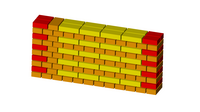 |
Very similar to English bond, but every stretcher course starts with a header. | French: appareil français |
cross_bond |
 |
Derived from block bond, but every second stretcher course is set off by a header. Each header has either a stretcher above or below and a joint below or above, whereas in block bond, it always has a stretcher above AND below. Decorational crosses can be formed by differently coloured bricks. Sometimes differentiated between English cross bond and Dutch cross bond, depending on whether English (size) bricks or Dutch (size) bricks were used.[3]. | Danish: Krydsforbandt
German: Kreuzverband |
scottish_bond |
 |
A course of headers followed by five courses of stretchers. See also below. | French: appareil américain |
american_bond |
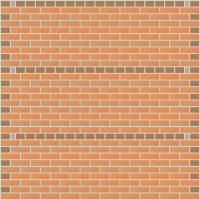 |
A course of headers followed by (at least 5, but up to) 9 courses of stretchers. Called 7-course American bond up to 9-course American bond in the United States of America. | French: appareil américain |
sussex_bond |
 |
Three stretchers, followed by a header, followed by three stretchers etc. In each course, a header is resting centered on a stretcher. | |
dutch_bond |
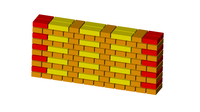 |
A course of headers followed by a course of alternating stretchers and headers. | French: appareil hollandais
Spanish: aparejo holandés |
silesian_bond |
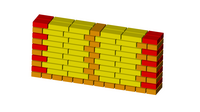 |
Two stretchers and one header with the headers overlapping from course to course. | |
gothic_bond |
 |
Alternating stretchers and headers with headers overlapping and stretchers overlapping from course to course.
Called staggered Flemish or zip bond in the US of A. |
German: Polnischer Verband or Gotischer Verband
French: appareil gothique |
rat_trap_bond |
 |
Used for hollow walls. Looks similar to flemish bond, but bricks are standing on the stretcher face. | |
| ??? |  |
Stretcher bond with gaps for ventilation or decoration. | French: appareil à claire-voie Spanish: aparejo palomero Portugese: aparelho aberto |
opus_spicatum |
 |
Ancient Roman and medieval bond (Wikipedia). Courses of diagonal bricks, sometimes broken by courses of stretchers. | |
stack_bond |
 |
Stretchers not overlapping. | |
irregular_bond |
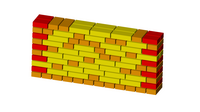 |
No discernible pattern, but certain rules apply. | French: appareil sauvage |
dog_tooth_course |
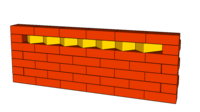 |
Also dog's tooth or saw tooth . Merely decorative, not for supporting walls (hence not a bond). Bricks are either laid turned 45° with the corner to facing out or every second header in a header bond set off inside the wall. | American English: Hound tooth course |
Mapping mistakes
Footnotes
You can use these for translating the page into other languages. Please delete them from the table, once the target language page is finished.
Further resources
- ↑ Use these for translating the page into other pages and delete the target page translation here in the column after.
- ↑ Calder Loth: Historic Bricks: A Design Resource (youtube)
- ↑ Calder Loth: Historic Bricks: A Design Resource (youtube)
